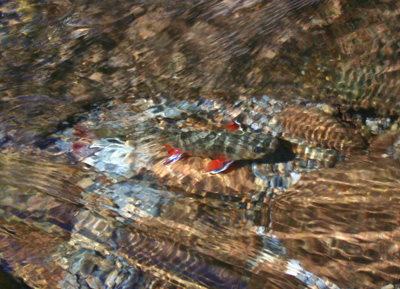Last week Great Smoky Mountains National Park fisheries biologist Matt Kulp spoke to the Little River Chapter of Trout Unlimited. The main focus of his presentation was the progress on the Lynn Camp Prong brook trout restoration in the Tremont section of the park near Townsend, Tennessee.
The project has been a tremendous challenge and has been without a doubt the most ambitious native trout restoration in this part of the country. All rainbow trout were removed from over 6 miles of stream with the compound antymicyn. It’s lethal to trout, but unlike rotenone, another toxin used in similar situations, antymicyn is not lethal to other aquatic organisms like insects, crayfish, and salamanders.
Native brook trout were collected from several streams around the national park and moved to Lynn Camp Prong. This provided native fish from multiple age brackets including young of the year brook trout as well as older, mature fish to spawn. Here’s a video from the summer of 2010 when biologists shocked Lynn Camp Prong to check on the status of the brook trout population about a year after they were reintroduced to the stream.
[youtube]http://youtu.be/D3RdGzSWboE[/youtube]
Less than a year after all rainbow trout were removed and brook trout reintroduced, a few exceptionally large rainbow trout were found in Lynn Camp Prong. Unfortunately these fish had the rubbed off fins typically found on hatchery fish. There was some reliable information that someone had taken some fish in coolers filled with water up the stream on horseback. Unfortunately those fish had spawned successfully and young rainbows were back in the stream among the recently reintroduced native brookies.
This required a major intervention by park biologists who proceeded to collect brook trout from that section of the stream with electrofishing equipment. These fish were moved into neighboring streams while a second antymicyn treatment was conducted where rainbow trout were found. Matt explained that this was necessary because the extremely small size of rainbow trout less than a year old coupled with the large pools and rapids of Lynn Camp Prong. This was the only way to be sure the small rainbow trout were removed. Electrofishing equipment was used later to re-collect the brook trout which had been moved out of Lynn Camp Prong, but the fish has so dispersed throughout those streams that only about 60% of the fish were re-captured and taken back.
Matt went on to say that in previous restoration efforts that brook trout populations had reached normal levels within three years. However, the temporary setback with hatchery rainbows and subsequent re-treatment coupled with high flows that limited brook trout reproduction had kept numbers low. High water conditions from late 2012 through the winter of 2013 washed out nearly all brook trout eggs and fry. The good news was that all of the adult fish were in excellent condition for spawning in autumn of 2013. Unfortunately the Smokies have just experienced another set of flooding rains that brought streams to a level that likely repeated the same situation from last year since water levels were just as high.
Here is a video of brook trout spawning in Lynn Camp Prong in November of 2013.
[youtube]http://youtu.be/_CdAnw3RY-s[/youtube]
This spring biologists plan to collect more native brook trout from around the national park to supplant those already in Lynn Camp Prong. Matt emphasized that the series of high water events we’ve seen wouldn’t be much of an issue for a well established population of brook trout but this isn’t the situation here. Fortunately the upper sections of the stream and its tributaries are full of fish but the lower reaches of the stream with bigger pools are lightly populated. This makes it hard for enough pairs of fish to find each other to have a successful spawn throughout the stream. Another round of fish brought into the stream should remedy this situation and hopefully next winter’s flows will return to normal levels.
Everyone involved in the project expected the population to be at full capacity by now but the unusual situation of two consecutive flood years has hampered the growth of the population. With the current fish in place and a few more added chances are good that population will grow dramatically by 2015.

